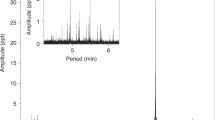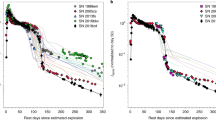Abstract
Stars that explode as supernovae come in two main classes. A type Ia supernova is recognized by the absence of hydrogen and the presence of elements such as silicon and sulphur in its spectrum; this class of supernova is thought to produce the majority of iron-peak elements in the Universe. They are also used as precise ‘standard candles’ to measure the distances to galaxies. While there is general agreement that a type Ia supernova is produced by an exploding white dwarf star1, no progenitor system has ever been directly observed. Significant effort has gone into searching for circumstellar material to help discriminate between the possible kinds of progenitor systems2, but no such material has hitherto been found associated with a type Ia supernova3. Here we report the presence of strong hydrogen emission associated with the type Ia supernova SN2002ic, indicating the presence of large amounts of circumstellar material. We infer from this that the progenitor system contained a massive asymptotic-giant-branch star that lost several solar masses of hydrogen-rich gas before the supernova explosion.
This is a preview of subscription content, access via your institution
Access options
Subscribe to this journal
Receive 51 print issues and online access
$199.00 per year
only $3.90 per issue
Buy this article
- Purchase on Springer Link
- Instant access to full article PDF
Prices may be subject to local taxes which are calculated during checkout





Similar content being viewed by others
References
Livio, M. in Supernovae and Gamma-Ray Bursts (eds Livio, M., Panagia, N. & Sahu, K.) 334–335 (STScI Symp. Vol. 13, Cambridge Univ. Press, Cambridge, 2001)
Lentz, E. J., Baron, E., Hauschildt, P. H. & Branch, D. Detectability of hydrogen mixing in type Ia supernova premaximum spectra. Astrophys. J. 580, 374–379 (2002)
Cumming, R. J., Lundqvist, P., Smith, L. J., Pettini, M. & King, D. Circumstellar Hα from SN 1994D and future type Ia supernovae: an observational test of progenitor models. Mon. Not. R. Astron. Soc. 283, 1355–1360 (1996)
Wood-Vasey, W. M. et al. Supernova 2002ic. IAU Circ. No. 8019 (2002)
Phillips, M. M. et al. SN 1991T: Further evidence of the heterogeneous nature of type Ia supernovae. Astron. J. 103, 1632–1637 (1992)
Li, W. et al. A high intrinsic peculiarity rate among type Ia supernovae. Astrophys. J. 546, 734–743 (2001)
Schlegel, E. M. A new subclass of type II supernovae? Mon. Not. R. Astron. Soc. 244, 269–271 (1990)
Chugai, N. N. The origin of supernovae with dense winds. Astron. Rep. 41, 672–681 (1997a)
Chugai, N. N. Supernovae in dense winds. Astrophys. Space Sci. 252, 225–236 (1997b)
Hamuy, M. in Core Collapse of Massive Stars (ed. Fryer, C. L.) (Kluwer, Dordrecht, in the press); preprint at 〈http://xxx.lanl.gov/astro-ph/0301006〉 (2003)
Hamuy, M. et al. Optical and infrared spectroscopy of SN 1999ee and SN 1999ex. Astron. J. 124, 417–429 (2002)
Germany, L. M., Reiss, D. J., Sadler, E. M., Schmidt, B. P. & Stubbs, C. W. SN 1997cy/GRB 970514: A new piece in the gamma-ray burst puzzle? Astrophys. J. 533, 320–328 (2000)
Turatto, M. et al. The properties of supernova 1997cy associated with GRB 970514. Astrophys. J. 534, L57–L61 (2000)
Turatto, M. et al. The type II supernova 1988Z in MCG + 03-28-022: Increasing evidence of interaction of supernova ejecta with a circumstellar ring. Mon. Not. R. Astron. Soc. 262, 128–140 (1993)
Arnett, D. Supernovae and Nucleosynthesis (Princeton Univ. Press, Princeton, 1996)
Aretxaga, I. et al. SN 1988Z: Spectro-photometric catalogue and energy estimates. Mon. Not. R. Astron. Soc. 309, 343–354 (1999)
Suntzeff, N. B. in Supernovae and Supernova Remnants (eds McCray, R. & Wang, Z.) 41 (IAU Colloq. 145, Cambridge Univ. Press, Cambridge, 1996)
Strolger, L.-G. et al. The type Ia supernova 1999aw: A probable SN 1999aa-like event in a low luminosity host galaxy. Astron. J. 124, 2905–2919 (2002)
Weidemann, V. Revision of the initial-to-final mass relation. Astron. Astrophys. 363, 647–656 (2000)
Iben, I. & Renzini, A. Asymptotic giant branch evolution and beyond. Annu. Rev. Astron. Astrophys. 21, 271–342 (1983)
Henry, R. B. C. & Worthey, G. The distribution of heavy elements in spiral and elliptical galaxies. Publ. Astron. Soc. Pacif. 111, 919–945 (1999)
Schlegel, D. J., Finkbeiner, D. P. & Davis, M. Maps of dust infrared emission for use in estimation of reddening and cosmic microwave background radiation foregrounds. Astrophys. J. 500, 525–553 (1998)
Hamuy, M., Phillips, M. M., Wells, L. A. & Maza, J. K corrections for type Ia supernovae. Publ. Astron. Soc. Pacif. 105, 787–793 (1993)
Phillips, M. M. et al. The reddening-free decline rate versus luminosity relationship for type Ia supernovae. Astron. J. 118, 1766–1776 (1999)
Stritzinger, M. et al. Optical photometry of the type Ia SN 1999ee and the type Ib/c SN 1999ex in IC 5179. Astron. J. 124, 2100–2117 (2002)
Hamuy, M. et al. The morphology of type Ia supernovae light curves. Astron. J. 112, 2438–2447 (1996)
Acknowledgements
All the co-authors participated in gathering the observations of the supernova. M.H. noticed the presence of hydrogen emission. M.M.P. noticed spectroscopic and photometric peculiarities and put forward the idea that these could be understood as due to SN/CSM interaction. N.B.S. provided the arguments about the progenitor types. M.H., M.M.P. and N.B.S. co-wrote this Letter. M.H. is a Hubble Fellow.
Author information
Authors and Affiliations
Corresponding author
Ethics declarations
Competing interests
The authors declare that they have no competing financial interests.
Supplementary information
41586_2003_BFnature01854_MOESM1_ESM.jpg
Supplementary Figure 1: Direct image of SN 2002ic. V-band CCD image of SN 2002ic taken on 2002 Dec. 9 UT with the Las Campanas Observatory Swope 1-m telescope. The horizontal bar corresponds to 1 arc min. North is up and East to the left. (JPG 9 kb)
Rights and permissions
About this article
Cite this article
Hamuy, M., Phillips, M., Suntzeff, N. et al. An asymptotic-giant-branch star in the progenitor system of a type Ia supernova. Nature 424, 651–654 (2003). https://doi.org/10.1038/nature01854
Received:
Accepted:
Issue Date:
DOI: https://doi.org/10.1038/nature01854
This article is cited by
-
Newly formed dust within the circumstellar environment of SN Ia-CSM 2018evt
Nature Astronomy (2024)
-
A radio-detected type Ia supernova with helium-rich circumstellar material
Nature (2023)
-
Ultraviolet Spectropolarimetry: on the origin of rapidly rotating B stars
Astrophysics and Space Science (2022)
-
Supernovae and their cosmological implications
La Rivista del Nuovo Cimento (2022)
-
Observational properties of thermonuclear supernovae
Nature Astronomy (2019)
Comments
By submitting a comment you agree to abide by our Terms and Community Guidelines. If you find something abusive or that does not comply with our terms or guidelines please flag it as inappropriate.



